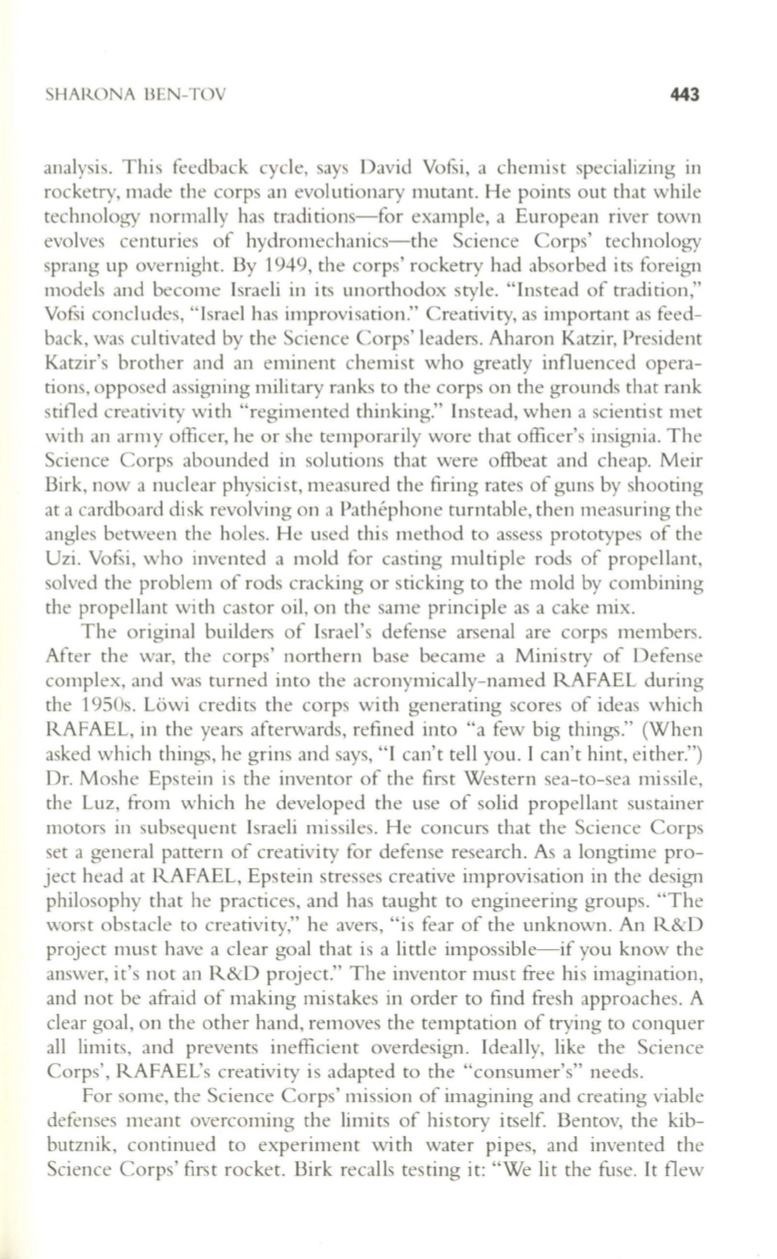
SHARONA BEN-TOV
443
analysis. This feedback cycle, says David Vofsi, a chemist specializing in
rocketry, made the corps an evolutionary mutant. He points out that while
technology normally has traditions-for example, a European river town
evolves centuries of hydromechanics-the Science Corps' technology
sprang up overnight. By 1949, the corps' rocketry had absorbed its foreign
models and become Israeli in its unorthodox style. "Instead of tradition,"
Vofsi concludes, "Israel has improvisation." Creativity, as important as feed–
back, was cultivated by the Science Corps' leaders. Aharon Katzir, President
Katzir's brother and an eminent chemist who greatly influenced opera–
tions, opposed assigning military ranks to the corps on the grounds that rank
stifled creativity with "regimented thinking." Instead, when a scientist met
with an army officer, he or she temporarily wore that officer's insignia. The
Science Corps abounded in solutions that were offbeat and cheap. Meir
Birk, now a nuclear physicist, measured the firing rates of guns by shooting
at a cardboard disk revolving on a Pathephone turntable, then measuring the
angles between the holes. He used this method to assess prototypes of the
Uzi. Vofsi, who invented a mold for casting multiple rods of propellant,
solved the problem of rods cracking or sticking to the mold by combining
the propellant with castor oil, on the same principle as a cake mix.
The original builders of Israel's defense arsenal are corps members.
After the war, the corps' northern base became a Ministry of Defense
complex, and was turned into the acronymically-named RAFAEL during
the 1950s. Lbwi credits the corps with generating scores of ideas which
RAFAEL, in the years afterwards, refined into "a few big things." (When
asked which things, he grins and says, "I can't tell you. I can't hint, either.")
Dr. Moshe Epstein is the inventor of the first Western sea-to-sea missile,
the Luz, from which he developed the use of solid propellant sustainer
motors in subsequent Israeli missiles. He concurs that the Science Corps
set a general pattern of creativity for defense research. As a longtime pro–
ject head at RAFAEL, Epstein stresses creative improvisation in the design
philosophy that he practices, and has taught to engineering groups. "The
worst obstacle to creativity," he avers, "is fear of the unknown. An R&D
project must have a clear goal that is a little impossible-if you know the
answer, it's not an R&D project." The inventor must free his imagination,
and not be afraid of making mistakes in order to find fresh approaches. A
clear goal, on the other hand, removes the temptation of trying to conquer
all limi ts, and prevents inefficient overdesign. Ideally, like the Science
Corps', RAFAEL's creativity is adapted to the "consumer's" needs.
For some, the Science Corps' 111ission of imagining and creating viable
defenses meant overcoming the li111its of history itself. Bentov, the kib–
butznik, continued to experiment wi th water pi pes, and invented the
Science Corps' first rocket. Birk recalls testing it: "We lit the fuse. It flew


